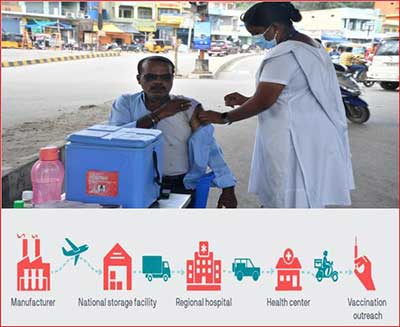Relevance: GS-2: Issues relating to the development and management of Social Sector/Services relating to Health.
Key Phrases: vaccine supply chains, vaccination programme, cold chain capacity, temperature monitoring and control, Electronic Vaccine Intelligence Network, National Health Mission, pandemic preparedness.
Why in News?
- Robust cold chain systems are an investment in India’s future pandemic preparedness.
Context:
- The pandemic reminded us that vaccines alone do not save lives, vaccination does. While we have, over the years, set up a strong service delivery network, the pandemic showed us that there were weak links in the chain, especially in the cold chain, which needs to be robust and seamless.
- In India, close to 20% of temperature-sensitive healthcare products arrive damaged or degraded because of broken or insufficient cold chains, including a quarter of vaccines. Wastage has cost implications and can delay the achievement of immunisation targets.
Why Cold Chain System is important for Healthcare System?
- The success of any sustainable vaccination programme relies on many factors. A key factor is cold chain management because when this fails, the potency or effectiveness of the vaccine is wasted. Nearly half the vaccines distributed around the world go to waste, in large part due to a failure to properly control storage temperatures.
- Temperature plays a crucial role in molecular dynamics as it can affect the stability of many compounds. The higher the temperature, the more the thermal energy can increase the chances of chemical compositions breaking and more stable ones forming. In the medical world, high temperatures can lead to irreversible changes within molecules found in various medications, thereby reducing their effectiveness.
- The same can happen to many vaccines and samples, such as blood, as they are biological products that are thermo-sensitive in nature. If they get exposed to inappropriate temperatures, important components they are made of can degrade, thus diminishing their potency.
- Once this happens, the clinical and research utility of these biological products are lost. Therefore, it is critical to maintain vaccines, medicines, and biological samples protected from temperature variations, and safely store and transport them across their supply chain networks.
Measures for Cold Chain Management:
There is a need to identify the root causes and solutions for three common issues limiting cold chain performance. i.e.
To address cold chain capacity:
- Developing an accurate picture of cold chain capacity gaps based on current and future needs.
- Resource mobilization.
- Effective monitoring during implementation.
To encourage up-gradation of the cold chain with the latest technology:
- Introduction of temperature monitoring and control (TMC) devices and practices.
- An effective cold chain relies on reliable cold chain equipment (CCEs) and temperature monitoring devices. These CCEs include electrical equipment like cold room/walk-in coolers and freezer room/walk-in freezers.
To address Human resources and Skillsets:
- The maintenance of vaccines in the cold chains requires adequate cold chain infrastructure, trained staff, and compliance with the standards. Cold chain handlers’ work experience, educational status, training on vaccine management, and utilization of EPI guidelines were among the factors that affect cold chain management practice.
Electronic Vaccine Intelligence Network
- The Health Ministry has been digitising the vaccine supply chain network in recent years through the use of cloud technology, such as with the Electronic Vaccine Intelligence Network (eVIN).
- The platform digitises information on vaccine stocks and temperatures across the country.
- It is aimed at strengthening immunization supply chain systems across the country.
- eVIN aims to support the Government of India’s Universal Immunization Programme by providing real-time information on vaccine stocks and flows, and storage temperatures across all cold chain points in the states.
- It is being implemented under the National Health Mission (NHM) by the Ministry of Health and Family Welfare in partnership with the United Nations Development Programme (UNDP).
- This supports healthcare workers in the last mile in supervising and maintaining the efficiency of the vaccine cold chain.
Way Forward:
- The role played by supportive infrastructure for the cold chain such as a regular supply of electricity cannot be underplayed. In this regard, there is a need to improve electrification, especially in the last mile, for which the potential of solar-driven technology must be explored to integrate sustainable development. For instance, in Chhattisgarh, 72% of the functioning health centres have been solarised to tackle the issue of regular power outages. This has significantly reduced disruption in service provision and increased the uptake of services.
- The learnings from the pandemic make it imperative that we look towards a future where the critical arteries that comprise the supply chain of immunisation facilities be strengthened. India has pioneered many approaches to ensure access to public health services at a scale never seen before. Robust cold chain systems are an investment in India’s future pandemic preparedness;
Source: The Hindu
Mains Question:
Q. Discuss the role of robust cold chain systems as an investment in India’s future pandemic preparedness. Comment.







